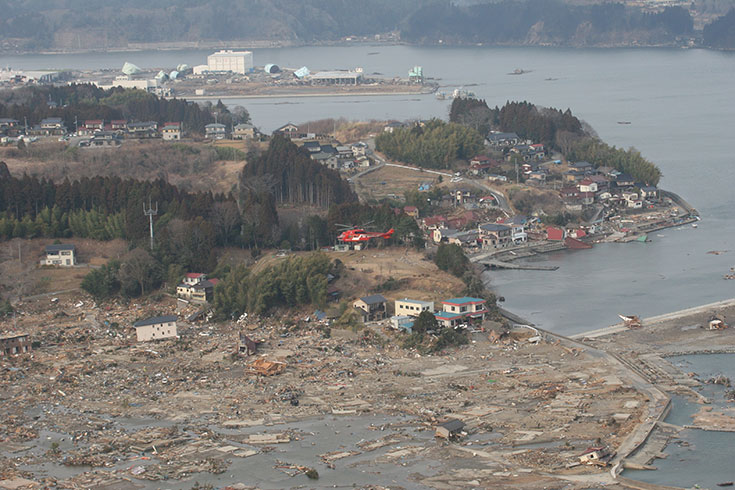Computer model adds a new layer of defence against earthquakes and tsunamis
The first computer model to simulate the whole chain of hazard events triggered by offshore mega subduction earthquakes could reduce losses to life and property caused by disasters such as the huge earthquake and tsunami that struck Japan six years ago last Saturday (March 11).

A helicopter from the Tokyo Fire Department surveys the damage after the Great East Japan earthquake and tsunami in 2011 (image courtesy TFD)
The new model has been developed by the Cascading Risk and Uncertainty Assessment of Earthquake Shaking and Tsunami (CRUS) project with funding from the Engineering and Physical Sciences Research Council (EPSRC). The University of Bristol, in collaboration with UCL, has led the work at the head of a multi-national consortium.
Designed to be used in any part of the world potentially vulnerable to offshore subduction earthquakes (where one tectonic plate is forced beneath another), such as Japan, New Zealand, the Pacific Northwest (US and Canada), Mexico, Chile and Indonesia, the model integrates every aspect of an undersea earthquake – including tsunamis, aftershocks and landslides – into a single disaster simulation tool.
By generating more comprehensive, more accurate maps of all potential hazards and a better understanding of how these are connected with each other, it can be used to strengthen emergency planning, improve evacuation strategies, enable engineers to calculate buildings' resilience more realistically and help the insurance industry produce more reliable financial risk analyses, for example.
In the past, risks posed by earthquakes and by the different threats associated with them, have been modelled separately, based on different methods, data and assumptions varying from one part of the world to another. This lack of integration and lack of a standard approach has limited models' real-world value as well as the benefits of information sharing between countries.
Dr Katsu Goda, Senior Lecturer in Civil Engineering in the University of Bristol's Department of Civil Engineering, who has led the CRUST team, says: “For the first time ever, we've brought genuine joined-up thinking to the whole issue of offshore giant subduction earthquakes and their links to tsunamis, aftershocks and landslides, taking account of how all of these are linked and how one type of event leads, or 'cascades', into another.”
With its ability to produce a more reliable and realistic picture of the entire sequence of events and to generate multi-hazard maps, the model will enable governments, emergency services, the financial industry and others to explore alternative disaster scenarios in detail. In the coming months, the CRUST team will focus on refining the model's capabilities as a truly predictive tool.
Dr Goda says: “The magnitude 9 Tohoku earthquake and resulting tsunami waves that hit the east coast of Japan on March 11, 2011 caused around 19,000 deaths, plus economic damage estimated at US$300 billion. We hope our simulation tool will secure wide rollout around the world and will be used to inform decision-making and boost resilience to these frequently devastating events.”